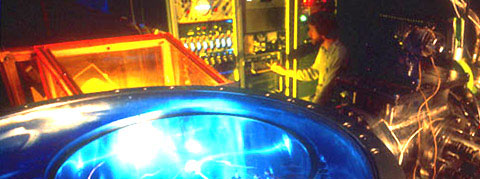| Posted: April 2, 2008 |
Nanoparticle clusters offer surprises for physical chemists |
|
(Nanowerk News) Extremely small scale materials behave differently than one might expect when they come into close proximity to one another. The principles of basic physical chemistry are not quite as clear cut as one might imagine. And it is these properties that inspire the research of Kit Bowen Jr., the E. Emmett Reid Professor of Chemistry in the Krieger School of Arts and Science and affiliated faculty member of the Institute for NanoBioTechnology.
|
|
Bowen studies the intermolecular action of nanoparticles and of clusters—aggregates of atoms and molecules. The study of size specific clusters provides an insightful means of addressing fundamental problems in physical chemistry, Bowen explains, and his lab is developing techniques to look at a very wide range of cluster components in biological systems, chemistry problems and material science.
|
 |
| Continuous negative ion mass spectrometer. (Image: Bowen Lab/JHU)
|
|
To study clusters, Bowen uses a very sensitive chemistry probe known as negative ion photoelectron spectroscopy, which is based on the fact that it takes a certain amount of energy to knock an electron from a negatively charged ion.
|
|
“The technique uses light to ionize excess electrons from negative ions,” Bowen says. “The measurement of the electrons’ energies gives information about the electronic structure of the neutral species produced when an electron leaves its anion.” Using this method, recent studies have discovered whole groups of chemical species, such as types of aluminum hydrides, not previously known to be possible. Another study co-authored by Bowen and published in Science examined electron-induced proton transfer in acid-base reactions ("Electron-Driven Acid-Base Chemistry: Proton Transfer from Hydrogen Chloride to Ammonia").
|
|
“In terms of application of this research, it is more oriented toward fundamental principle studies,” Bowen says. “However, it could possibly be useful for future hydrogen storage applications, magnetic tapes, and as catalysts.”
|
|
In an academic setting, Bowen has been able to freely pursue novel ideas, something that might not be possible in industry. “Industry needs science to guide their production development just like sailors need the North Star to navigate at night,” he says, adding that collaboration has been important for his academic endeavors. “Every professor has different skills.”
|
|
Bowen’s passion for science is contagious and he is devoted to scientific outreach, realizing the importance of being exposed to science at a young age. In the past, some high school and even middle school students have spent time over the summer in Bowen’s lab. Some of the students chose to further their education in science as a result. Several have gone on to earn their PhD’s in chemistry or physics, he says.
|

